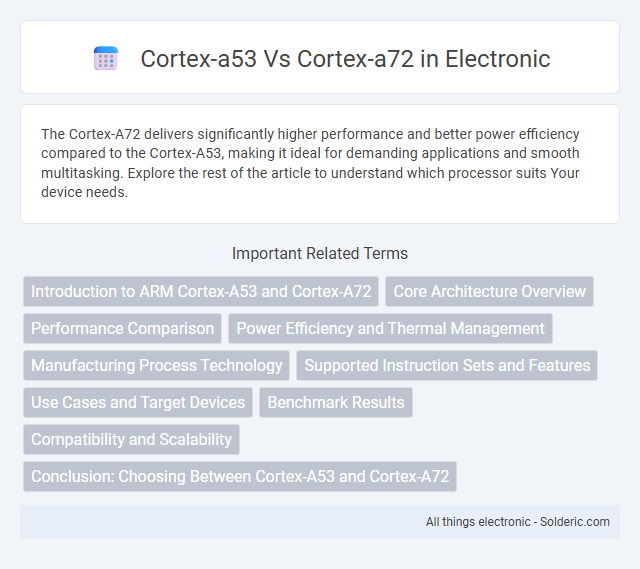The Cortex-A72 delivers significantly higher performance and better power efficiency compared to the Cortex-A53, making it ideal for demanding applications and smooth multitasking. Explore the rest of the article to understand which processor suits Your device needs.
Comparison Table
| Feature | Cortex-A53 | Cortex-A72 |
|---|---|---|
| Architecture | ARMv8-A 64-bit | ARMv8-A 64-bit |
| Core Type | Energy-efficient, in-order | High-performance, out-of-order |
| Performance | 1.2 - 1.5 DMIPS/MHz | 3.0 - 3.5 DMIPS/MHz |
| Frequency Range | Up to 1.5 GHz | Up to 2.5 GHz |
| Pipeline Depth | 8 stages | 15 stages |
| L1 Cache | 32 KB instruction + 32 KB data | 48 KB instruction + 32 KB data |
| L2 Cache | Up to 512 KB | Up to 1 MB |
| Target Use | Low-power devices, smartphones | High-end mobile, servers |
| Power Efficiency | High | Moderate |
Introduction to ARM Cortex-A53 and Cortex-A72
ARM Cortex-A53 is a power-efficient 64-bit processor designed for balanced performance and low energy consumption, commonly used in mid-range smartphones and embedded systems. Cortex-A72 offers significantly higher processing power and advanced features for demanding applications such as high-end mobile devices and networking equipment, built on a more aggressive microarchitecture. Both processors support ARMv8-A architecture, but Cortex-A72 delivers superior performance scaling with better out-of-order execution and cache hierarchy.
Core Architecture Overview
The Cortex-A53 features a 64-bit ARMv8-A architecture optimized for power efficiency and moderate performance, making it ideal for low to mid-range devices. The Cortex-A72, built on the same ARMv8-A architecture, offers a more advanced out-of-order execution pipeline and higher clock speeds, delivering significantly greater performance for demanding applications. Your choice between Cortex-A53 and Cortex-A72 cores depends on the balance you seek between energy consumption and processing power.
Performance Comparison
The Cortex-A72 delivers significantly higher performance than the Cortex-A53, with up to 1.8 to 2 times better speed due to its advanced microarchitecture and higher clock speeds. Cortex-A72 features out-of-order execution and larger pipelines, optimizing tasks requiring intensive processing power, while Cortex-A53 relies on an energy-efficient in-order design suited for basic applications. Your device's performance will notably improve in multitasking and demanding applications when using Cortex-A72 compared to the power-efficient Cortex-A53.
Power Efficiency and Thermal Management
The Cortex-A53 architecture prioritizes power efficiency with a compact design and lower clock speeds, making it ideal for devices requiring long battery life and minimal thermal output. In contrast, the Cortex-A72 delivers higher performance with increased power consumption and heat generation, demanding advanced thermal management solutions in your device. Choosing between these cores hinges on balancing Your need for efficient energy use versus peak processing power and thermal constraints.
Manufacturing Process Technology
The Cortex-A53 is built using an older 28nm manufacturing process technology, which offers efficient power consumption but lower performance density. In contrast, the Cortex-A72 utilizes a more advanced 16nm FinFET process, delivering enhanced performance and energy efficiency through smaller transistor sizes and improved thermal management. Your choice between these cores may depend on whether you prioritize lower power usage or higher processing capabilities enabled by the updated manufacturing technology.
Supported Instruction Sets and Features
The Cortex-A72 supports ARMv8-A architecture with 64-bit processing and advanced features like ARM TrustZone and NEON SIMD, offering improved performance and efficiency over the Cortex-A53, which supports both ARMv7-A (32-bit) and ARMv8-A (64-bit) architectures. Your choice between these cores impacts instruction set availability, with the A72 providing more robust cryptographic extensions and hardware virtualization capabilities. The A53 focuses on energy-efficient operation with a simpler pipeline, while the A72 integrates enhanced out-of-order execution and a larger micro-op cache for demanding computational tasks.
Use Cases and Target Devices
Cortex-A53 processors are optimized for energy-efficient tasks in entry-level smartphones, IoT devices, and low-power embedded systems, making them ideal for budget-friendly and battery-conscious applications. Cortex-A72 cores deliver higher performance and are designed for premium smartphones, tablets, and networking equipment requiring intensive computational power, such as 4K video processing and complex AI workloads. The distinct use case targeting balances cost and power efficiency for Cortex-A53 against raw performance and advanced capabilities in Cortex-A72, reflecting their deployment in diverse device categories.
Benchmark Results
Benchmark results reveal the Cortex-A72 significantly outperforms the Cortex-A53 in terms of processing power and efficiency, delivering up to 50-60% higher single-thread performance. The A72's advanced microarchitecture supports higher clock speeds and better out-of-order execution, resulting in faster app loading times and smoother multitasking. Your device will benefit from improved performance in demanding applications and gaming when powered by the Cortex-A72.
Compatibility and Scalability
The Cortex-A53 supports 32-bit and 64-bit instruction sets, ensuring broad compatibility with legacy and modern applications, while the Cortex-A72 is designed primarily for high-performance 64-bit systems. The Cortex-A72 offers greater scalability with higher clock speeds, improved out-of-order execution, and advanced pipeline architecture, allowing it to efficiently handle more demanding workloads in multi-core configurations. Both cores integrate seamlessly within ARM's big.LITTLE architecture, enabling heterogeneous multi-processing to optimize power consumption and performance across diverse device requirements.
Conclusion: Choosing Between Cortex-A53 and Cortex-A72
Cortex-A72 outperforms Cortex-A53 significantly in terms of processing power and energy efficiency, making it ideal for high-performance applications and demanding workloads. Cortex-A53 offers a more cost-effective solution with lower power consumption, suitable for budget devices and tasks requiring moderate performance. Your choice depends on whether you prioritize raw performance with Cortex-A72 or balance efficiency and affordability with Cortex-A53.
cortex-a53 vs cortex-a72 Infographic

 solderic.com
solderic.com